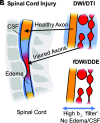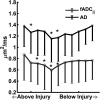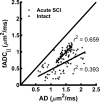Filtered Diffusion-Weighted MRI of the Human Cervical Spinal Cord: Feasibility and Application to Traumatic Spinal Cord Injury
- PMID: 34620590
- PMCID: PMC8583257
- DOI: 10.3174/ajnr.A7295
Filtered Diffusion-Weighted MRI of the Human Cervical Spinal Cord: Feasibility and Application to Traumatic Spinal Cord Injury
Abstract
Background and purpose: In traumatic spinal cord injury, DTI is sensitive to injury but is unable to differentiate multiple pathologies. Axonal damage is a central feature of the underlying cord injury, but prominent edema confounds its detection. The purpose of this study was to examine a filtered DWI technique in patients with acute spinal cord injury.
Materials and methods: The MR imaging protocol was first evaluated in a cohort of healthy subjects at 3T (n = 3). Subsequently, patients with acute cervical spinal cord injury (n = 8) underwent filtered DWI concurrent with their acute clinical MR imaging examination <24 hours postinjury at 1.5T. DTI was obtained with 25 directions at a b-value of 800 s/mm2. Filtered DWI used spinal cord-optimized diffusion-weighting along 26 directions with a "filter" b-value of 2000 s/mm2 and a "probe" maximum b-value of 1000 s/mm2. Parallel diffusivity metrics obtained from DTI and filtered DWI were compared.
Results: The high-strength diffusion-weighting perpendicular to the cord suppressed signals from tissues outside of the spinal cord, including muscle and CSF. The parallel ADC acquired from filtered DWI at the level of injury relative to the most cranial region showed a greater decrease (38.71%) compared with the decrease in axial diffusivity acquired by DTI (17.68%).
Conclusions: The results demonstrated that filtered DWI is feasible in the acute setting of spinal cord injury and reveals spinal cord diffusion characteristics not evident with conventional DTI.
© 2021 by American Journal of Neuroradiology.
Figures





References
Publication types
MeSH terms
Grants and funding
LinkOut - more resources
Full Text Sources
Medical
